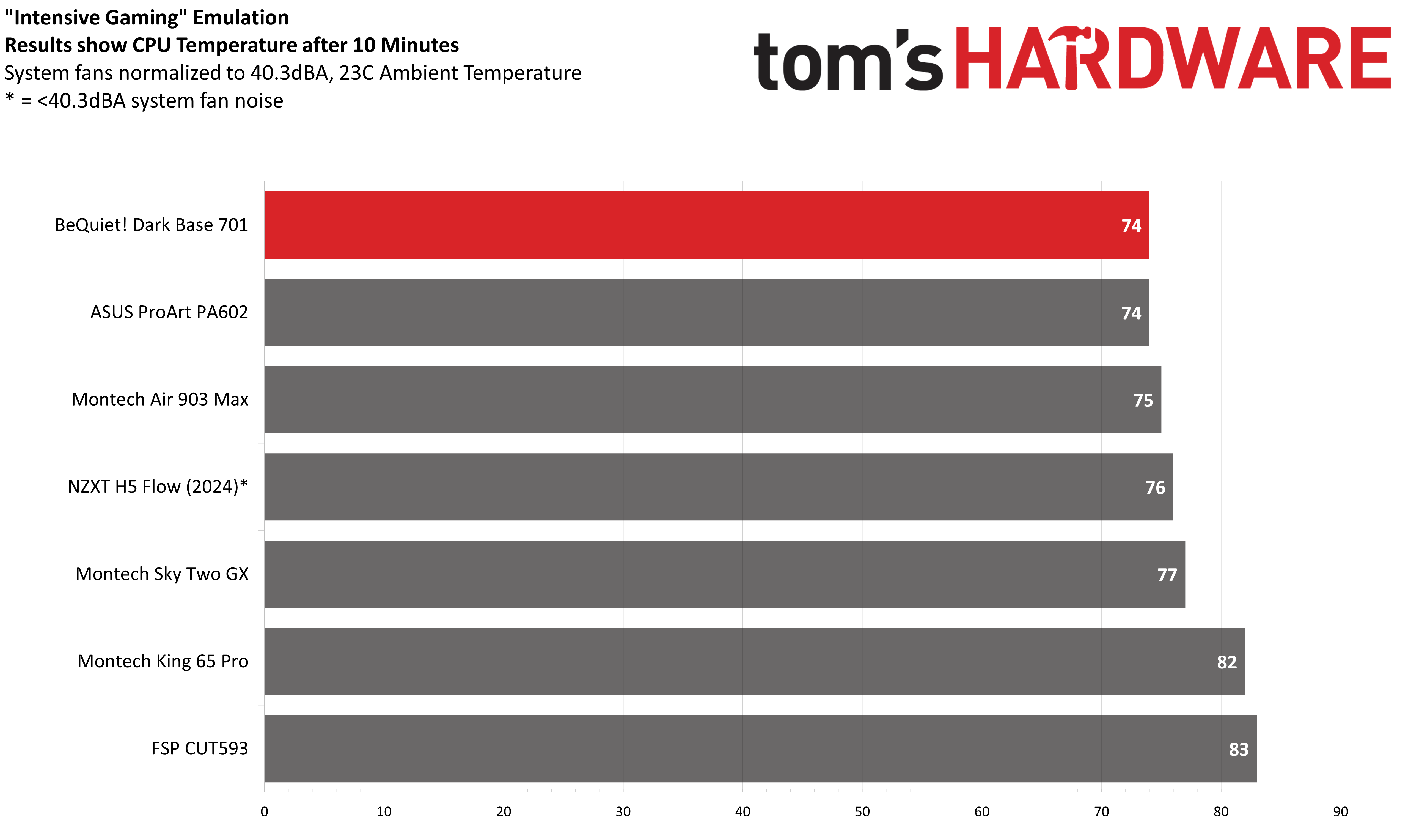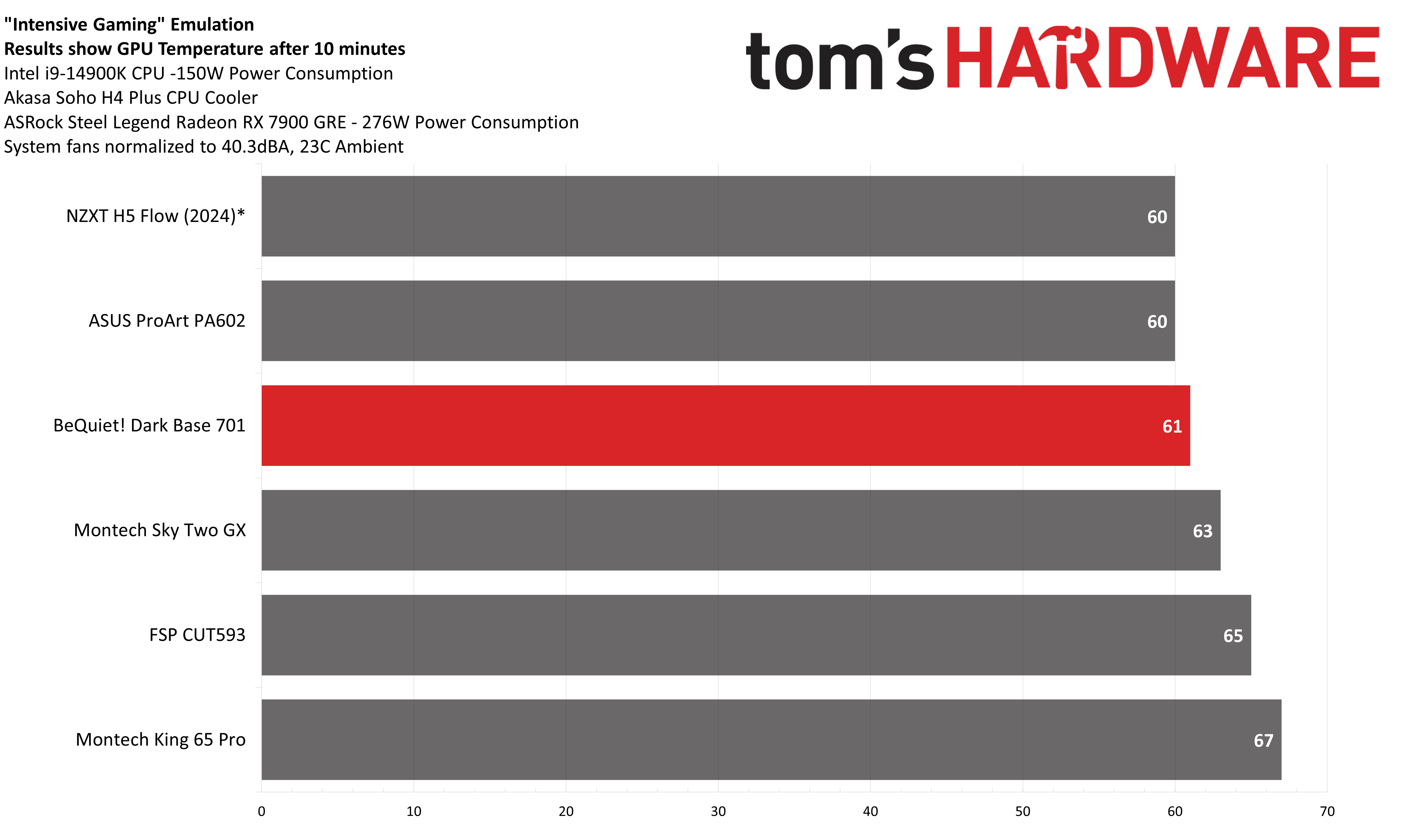Why you can trust Tom's Hardware
Noise Levels

Be Quiet’s Dark Base 701 has a maximum noise level of 46.3 dBA. These fans also have a pleasant low tone which sounds softer to my ears than the dBA rating would indicate.
Maximum Thermal Load – CPU Results
For this first test, I removed power limits from the Intel i9-14900K CPU and ran Cinebench R23 while also running Furmark 2 on the Radeon RX 7900 GRE GPU. This causes total system power consumption to reach around 600W.
This should be considered a “maximum performance” or “worst-case” scenario.

During this test, where both the GPU and CPU are pumping heat into the case, the CPU consumed an average of 261.7 Watts. This is less than half a watt behind the best two results shown in this chart, a difference so small that it’s not likely to make a difference in even a synthetic benchmark result.
Maximum Thermal Load – VRM Results
Another way to judge this same scenario is by looking at the motherboard’s VRM temperatures.

Keeping in mind that I am testing cases with their default fan configuration, Be Quiet’s choice to utilize two rear exhaust fans – one at the top and one at the rear – results in the best VRM thermals tested of the five cases I’ve tested this way.
Maximum Thermal Load – GPU Temperature Results

There’s not a big difference in the thermal performance of the GPU I’m using between cases. I suspect that I would need a more power-hungry GPU to see a more significant thermal difference. In my tests running Furmark 2, the 7900 GRE GPU will use approximately 276W. However, in today’s market that is merely mid-range power consumption. Nvidia’s RTX 4090 will consume twice as much power in the same scenario.
Get Tom's Hardware's best news and in-depth reviews, straight to your inbox.
That said, Be Quiet’s Dark Base 701 provided the best GPU thermals of the five cases I’ve tested it against today, with an average temperature of only 55.8 degrees C.
Impact on cooling with different fan speeds and noise levels
Since Be Quiet’s Dark Base 701 front IO supports changing fan speeds at the click of a button, I wanted to see what the impact of these settings would be on maximum thermal performance and noise levels. You can choose between 1900 RPM, 1200 RPM, and 600 RPM (+-10%).

Noise levels varied from 37 dBA to 46.3 dBA depending on which setting you chose. The lowest setting of 37dBA is a mere fraction of the perceptible noise impact of the fastest speed, but that comes with an 8% reduction in maximum theoretical thermal performance.
You may notice that the chart above starts at 35dBA. First, 35dBA was chosen as the “zero” here because it is the lowest level my noise meter can accurately measure. But also, noise level measurements are logarithmic. A person with typical hearing will perceive a doubling of noise for every 10 dBA increase, but the impact can vary from person to person.

Maximum Thermal Load – Noise Normalized
For this next test, I’ve set the system fans to run at 40.3 dBA on cases with PWM control. I’ve also normalized the output of Akasa’s Soho H4 Plus, setting it to 76% - 40.9 dBA from one meter away.
You can consider this a measure of the case’s efficiency when set to low noise levels.

BeQuiet’s Dark Base 701 technically performed in the middle of the results we have here, but the performance gap between it and the best result is small. Montech’s Air 903 Max sustains a mere 1.9W higher in this scenario.
Intense Gaming Thermal Load
The last test I’ve performed for this review is to task the cooling with a moderately intensive gaming workload. For this, I’ve set the Intel i9-14900K CPU’s power consumption to 150W while running a full load on a Radeon RX 7900GRE GPU, which consumes approximately 276W. This is similar to what I’ve experienced with these components when playing Ubisoft’s Far Cry V.

The CPU reached only 74C at the end of our tests, the best result we have from any of the cases tested thus far. That’s only one half of the story though. How about the GPU’s temperatures? Those were good too, at 61 degrees C.

Conclusion
Be Quiet’s Dark Base 701 is a premium-quality computer case that supports a wide variety of customization options, including one-click modification of fan and lighting settings, vertical GPU support, multiple storage drives, and even support for custom liquid cooling reservoirs. This high-end product is paired with a price tag reflecting that quality, at $229 USD. But it also often goes on sale. When I wrote this, it was currently selling for just $169.99.
My only complaint about Be Quiet’s Dark Base 701 is that it feels like it could be even more customizable – sealing the top of the unit with a solid cover and replacing the glass panel with a second foam-absorbing side panel would improve the noise reduction properties of this case. Of course, you’d also have to adjust your fans accordingly and forego a top-mounted radiator in that scenario.
MORE: Best PC Cases
MORE: Best Mini-ITX Cases

Albert Thomas is a contributor for Tom’s Hardware, primarily covering CPU cooling reviews.
